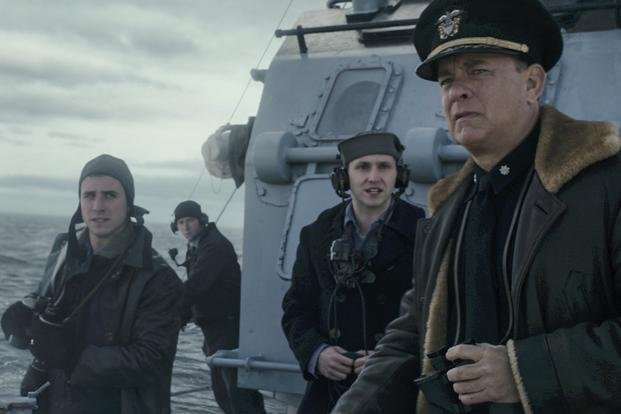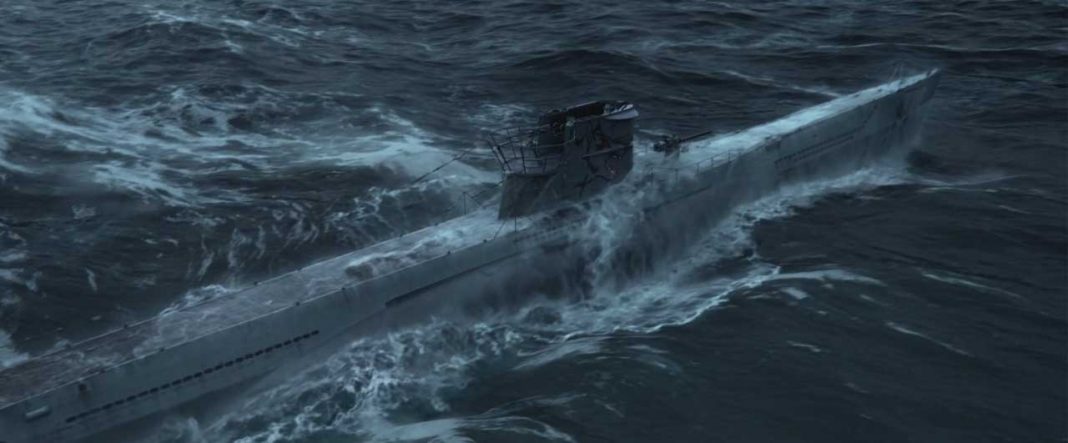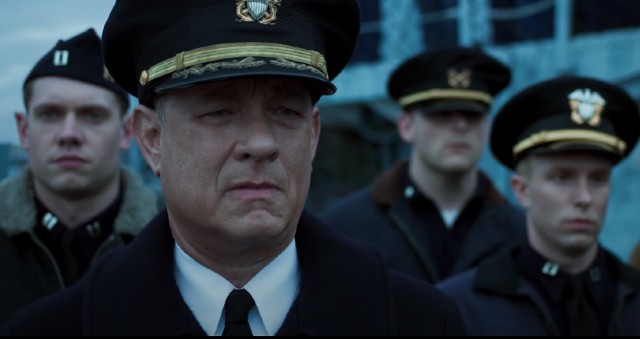The film follows the US Navy Commander Ernest Krause during WW II. He is assigned to lead an Allied convoy across the Atlantic. The convoy of 37 ships carrying Allied troops and supplies is being pursued by German U-boats. Commander Ernest has to navigate and transport the convoy across the dangerous ‘Black Pit.’ As the Nazi German submarines chase the convoy with torpedos, Ernest must engage them and traverse through the stormy waters.
The Allied convoy and enemy U-boats
During the “Battle of the Atlantic,” a convoy of 37 Allied ships is traversing through the ocean from the US to Liverpool, UK. The convoy is carrying Allied troops and supplies. Leading the convoy is the USS Keeling, a Fletcher-class destroyer. Its call sign is “Greyhound.” Another one in the escort fleet is the British destroyer with the call sign, “Harry.” The Polish destroyer’s call sign is Eagle with the Canadian Flower-class corvette, “Dicky”. These ships make the escort leading the convoy, with Ernest serving as the overall commander of the escort ships. Ernest has an extensive amount of naval knowledge and is a senior, yet this is his first wartime job. The convoy enters the “Black Pit,” a dangerous part of the Atlantic ocean. This region is out-of-bounds for aircraft cover. The convoy is still 3 days away before air cover can resume. That is when the Hight Frequency Direction Finding (aka HuffDuff) intercepts German transmissions. The interception results in the detection of German U-boats in proximity. The radar operator at Greyhound identifies a sub-surface submarine that’s heading towards the convoy. Ernest commands the men to swerve from the convoy and intercept the U-boat. Greyhound gets within the firing range, but the stormy waters help the U-boat submerge before the visuals could be taken. Soon enough, sonar contact is re-established. The submarine tries to make its way beneath the Greyhound, but Ernest commands the ship to safety. With excellent manoeuvre skills, Ernest positions the Greyhound on top of the sub and fires a pattern full of depth charges. Also Read: • The Father Review: A Painful Story About Dementia • Honest Thief Review: A Decent But Forgettable Flick
The Wolfpack submarines
The Greyhound crew celebrates following the first kill, but the celebrations are short-lived. They soon receive reports of distress rockets being fired at the back of the convoy. The distress rocket was fired from a Greek merchant ship. A U-boat attacked the ship, and it is sinking fast. Ernest turns the ship towards the distress call. On their way to the rescue, they are fired at with several torpedos, which Greyhound evades, thanks to Krause’s manoeuvring. The Greek survivors are eventually rescued. After that, the Greyhound returns to the convoy when they get alarming reports from other escort ships. Reports tell of a Wolfpack of 6 Nazi U-boats floating outside of the convoy’s firing range. Ernest tells Charlie that the enemies are waiting for nightfall. He suspects that they’re waiting it out until the escort ships have no visibility. Ernest chooses to rescue the burning oil tanker survivors rather than rescuing other ships first. He later comes to regret this decision. The next day, Greyhound gets attacked by the “wolfpack” submarines. Greyhound and other escort ships receive a radio transmission from the wolf pack. The captain of the leading Nazi sub, going by the callsign “Grey Wolf,” taunts the convoy and the destroyers. He threatens the convoy to attack and sink them all. Meanwhile, Ernest finds out that the ship has only 6 depth charges in total. Retaliating to an underwater attack is out of the question now. Soon, the wolf pack submarines launch many torpedoes. Greyhound evades them with minute margins.
Greyhound’s maneuvers and victory
Greyhound and the destroyer Dicky combine their forces and ensnare a U-boat. They succeed in sinking the boat but suffer damages. Dicky reviews minor damages while Greyhound gets hit on the port side by enemy U-boat’s guns. The firing results in 3 casualties aboard the Greyhound, Krause’s mess attendant George Cleveland being one of them. Before the funeral service ends, Eagle is attacked and consequently sinks. Krause has a word with second-in-command Charlie and talks about sending a message to the admiralty. Knowing that it might reveal the crumbling state of the escort fleet, they break the radio silence and transmit a single word, “Help.” The convoy heads closer to the region where air support will be possible. But the remnant faction of the U-boat fleet goes on an all-out offensive. Greyhound evades one torpedo within a hair’s length while one scrapes off its surface and deflects. After an intense fight, Greyhound successfully sinks the “Grey Wolf.” And soon enough, British air support arrives. Greyhound uses its guns to point the aircraft to where the last remaining U-boat is. The air bomber deploys depth charges and sinks the U-boat. Krause at the Greyhound receives a radio contact from the head of the relief escorts. He informs Krause that the relief has arrived and Greyhound is due to repair. The head is astonished and praises the first-timer Krause on his four U-boat kills. The crew gets a “job well done,” and Krause gives the deck’s commands over to a junior officer. As Ernest finally takes a breather, the crew realizes that it’s the first time since he has had command of the ship for the last 48 hours. The troops and passengers of the convoy cheer on and shoot flares to salute Greyhound’s crew for their victory.
Tom Hanks elevates Greyhound.
Going into the film, it becomes apparent that Tom Hanks is really drawn to this genre. He has written the screenplay along with being at the helm. His performance, although not as comparable as the past ones holds and elevates the film. What could have been a disastrous jargon-filed affair is humane and emotive, thanks to his performance? The sporadically dispersed moments of grief, doubt, and fear make the film a more sea combat thriller. Hanks imbues the frames with his great acting skills. You can also see how this film is a passionate project of his. Hanks plays Ernest Krause, a US Navy Commander. He has embarked on his very first wartime command. He has to face great challenges in the form of Nazi German submarines and treacherous waters. Although the screentime for character development is minimal, Hanks does make the most of it. He plays a man of religion, shown to be praying at the start and the end of the film. And that makes it kind of redundant. In a film where total screentime for proper character interactions and development barely exceeds 5 minutes, I don’t see the points of showing us time and again that he’s a man of religion. Besides that, Hanks manages to bring charisma to the role and is believable as a first-timer commander. He also makes the character’s great manoeuvring skills and éclat. Also read: • Tom & Jerry Review: An Unfunny Nostalgia Cash Grab • Crazy About Her: A Well Balance Dramedy
The use of jargon and lack of proper character development might drag Greyhound for some.
Besides Hanks and scant amounts of Stephen Graham, other characters get little time during this slick 90-minute runtime. But the anxiety and innocence among the ship’s men are conveyed, albeit not very effectively. The battles are great, and the tension every time a torpedo approaches the ship is substantial. There are ample amounts of CGI, but the sound design and cinematography make the battles and manoeuvres feel tangible. There is loads of jargon that will certainly appeal to the Naval historians. Shouting about rudders and degrees makes up for the greater part of the film. However, it doesn’t mean that the audiences are left alienated by it. In fact, I had a fairly easy time following the jargon-filled commands and reports. Moving the rudder hard left and hard right was pretty understandable. So was the degrees and yards for the distance that U-boats closed-up. As a naval war film, it is incredibly accurate, and a great deal of attention is paid to the different complex aspects of it. And a lean and tight 80 or so minutes are effectively used with a no-nonsense approach. That is sure to appeal to a lot of the viewers.
Verdict
My only issue with the movie will be that the characters do not get nearly enough time to develop. Krause is waiting for his reunion with his love interest, played by Elisabeth Shue and shown to be a religious man. But other characters get a few lines like, “Aye, sir,” or other naval jargon. We don’t quite see the enemy either, besides the taunting radio transmission from their leader. It might work for some, might not for others. The film’s action sequences and cinematography is praise-worthy and would be given justice on a big screen. You can stream Greyhound on Apple TV+.



